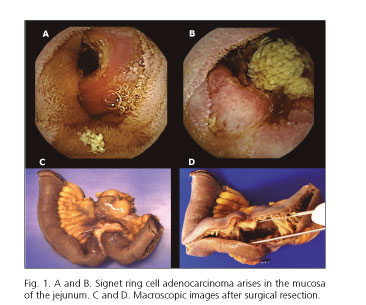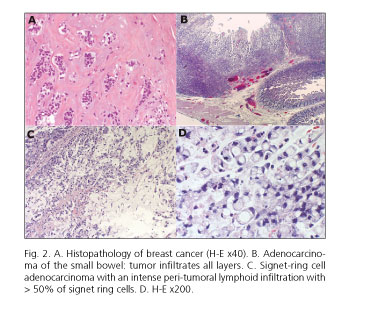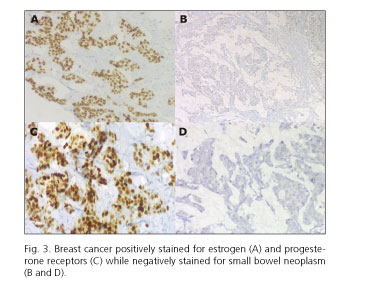Mi SciELO
Servicios Personalizados
Revista
Articulo
Indicadores
-
 Citado por SciELO
Citado por SciELO -
 Accesos
Accesos
Links relacionados
-
 Citado por Google
Citado por Google -
 Similares en
SciELO
Similares en
SciELO -
 Similares en Google
Similares en Google
Compartir
Revista Española de Enfermedades Digestivas
versión impresa ISSN 1130-0108
Rev. esp. enferm. dig. vol.109 no.2 Madrid feb. 2017
PICTURES IN DIGESTIVE PATHOLOGY
Signet ring cell carcinoma of the jejunum: an uncommon finding within the reach of capsule endoscopy
José Francisco Juanmartiñena1,2, Marta Montes3 and Ignacio Fernández-Urién1,2
Departments of 1Endoscopy, 2Digestive Diseases and
3Pathology. Complejo Hospitalario de Navarra. Pamplona, Spain
Case report
An 80-year-old female, with a history of ductal breast carcinoma (stage II) three years earlier, presented with asthenia and iron-deficiency anemia. No diagnosis was obtained after conventional endoscopy, and iron supplements were indicated. Ten months later, visible digestive hemorrhage occurred. Upper and lower endoscopy was repeated but no diagnosis was obtained. Thus, video capsule endoscopy was indicated, identifying a stenotic lesion arising in the mucosa of distal jejunum (Fig. 1). Histopathological examination (Fig. 2) revealed a poorly mucinous differentiated signet-ring cell adenocarcinoma with an intense peri-tumoral lymphoid (Crohn's-like lymphoid reaction) and lympho-vascular infiltration with no nodal metastases (pT3N0; 7th edition TNM classification). Immunochemistry revealed negative staining for estrogen and progesterone receptors in contrast with prior breast cancer. Thus, metastatic origin was ruled out (Fig. 3).
Discussion
Primary small-bowel malignancies are extremely rare (1). They account for 2% of all gastrointestinal tract malignancies. Carcinoid tumor (40%), adenocarcinoma (33%), lymphoma (17%) and sarcoma (8%) are the most common histological types. Symptomatic lesions are rare but, when present, gastrointestinal bleeding, abdominal pain and weight loss are the most common digestive symptoms. Primary signet ring cell adenocarcinoma is a rare histopathological variety of adenocarcinoma with poor prognosis, usually identified in esophageal or gastric locations (95%). They are less commonly detected in remaining gastrointestinal tract (2,3) and, when present, metastatic origin must always be ruled out. Nowadays, delayed diagnosis is common and leads to the detection of small bowel neoplasms at late stages with poor treatment outcomes. Thus, capsule endoscopy may help to improve this situation as it may identify them at early stages.
References
1. Bilimoria KY, Bentrem DJ, Wayne JD, et al. Small bowel cancer in the United States: Changes in epidemiology, treatment, and survival over the last 20 years. Ann Surg 2009;249:63-71. DOI: 10.1097/SLA.0b013e31818e4641. [ Links ]
2. Iizawa H, Ikeda E, Sato T, et al. Signet-ring cell carcinoma of the ileum: Report of a case and review of the Japanese literature. Surg Today 1998;28:1168-71. DOI: 10.1007/s005950050306. [ Links ]
3. Yamagami H, Oshitani N, Suekane T, et al. Signet-ring cell carcinoma of the jejunum diagnosed by double balloon enteroscopy. Hepatogastroenterology 2008;55:1246-8. [ Links ]
















